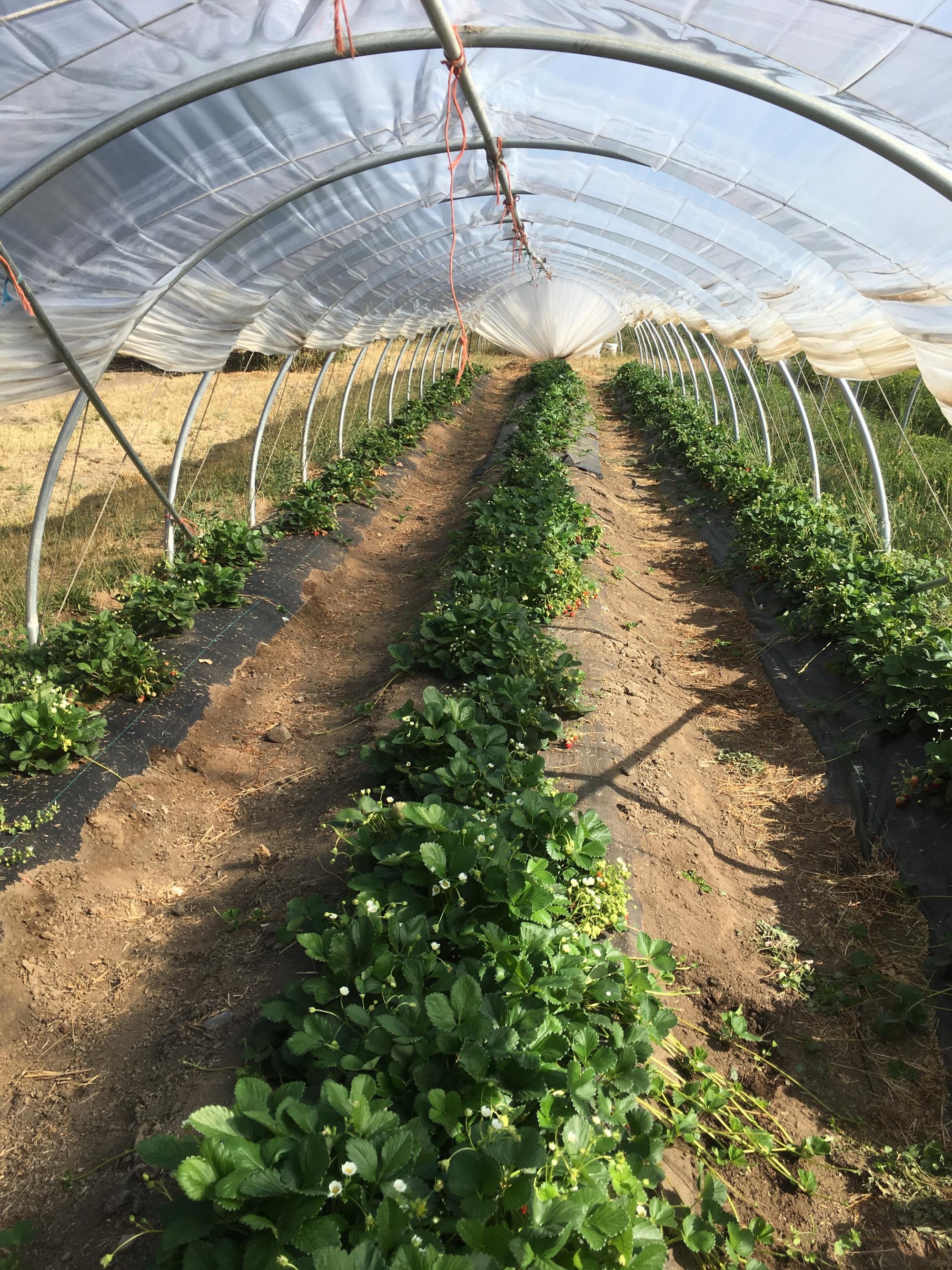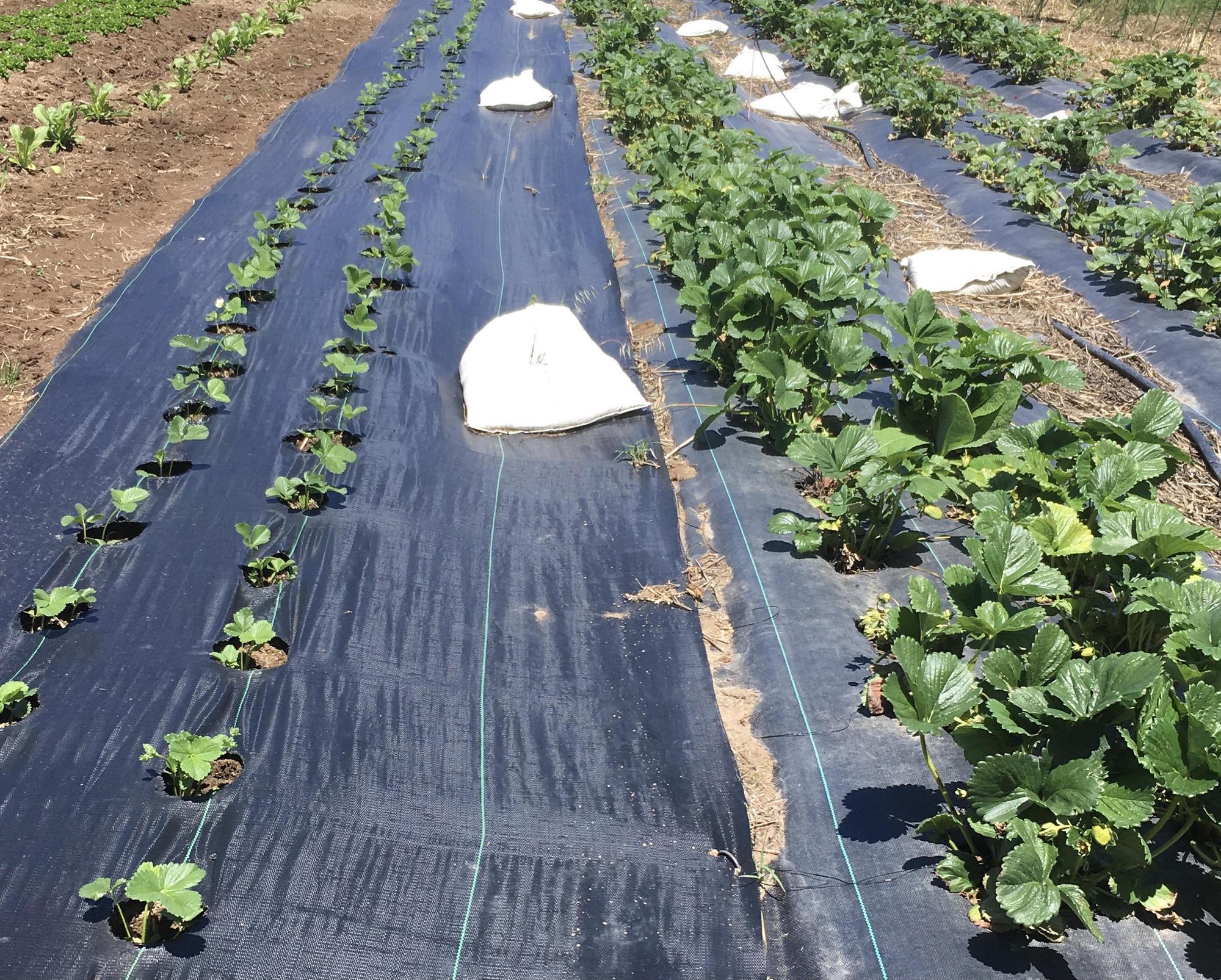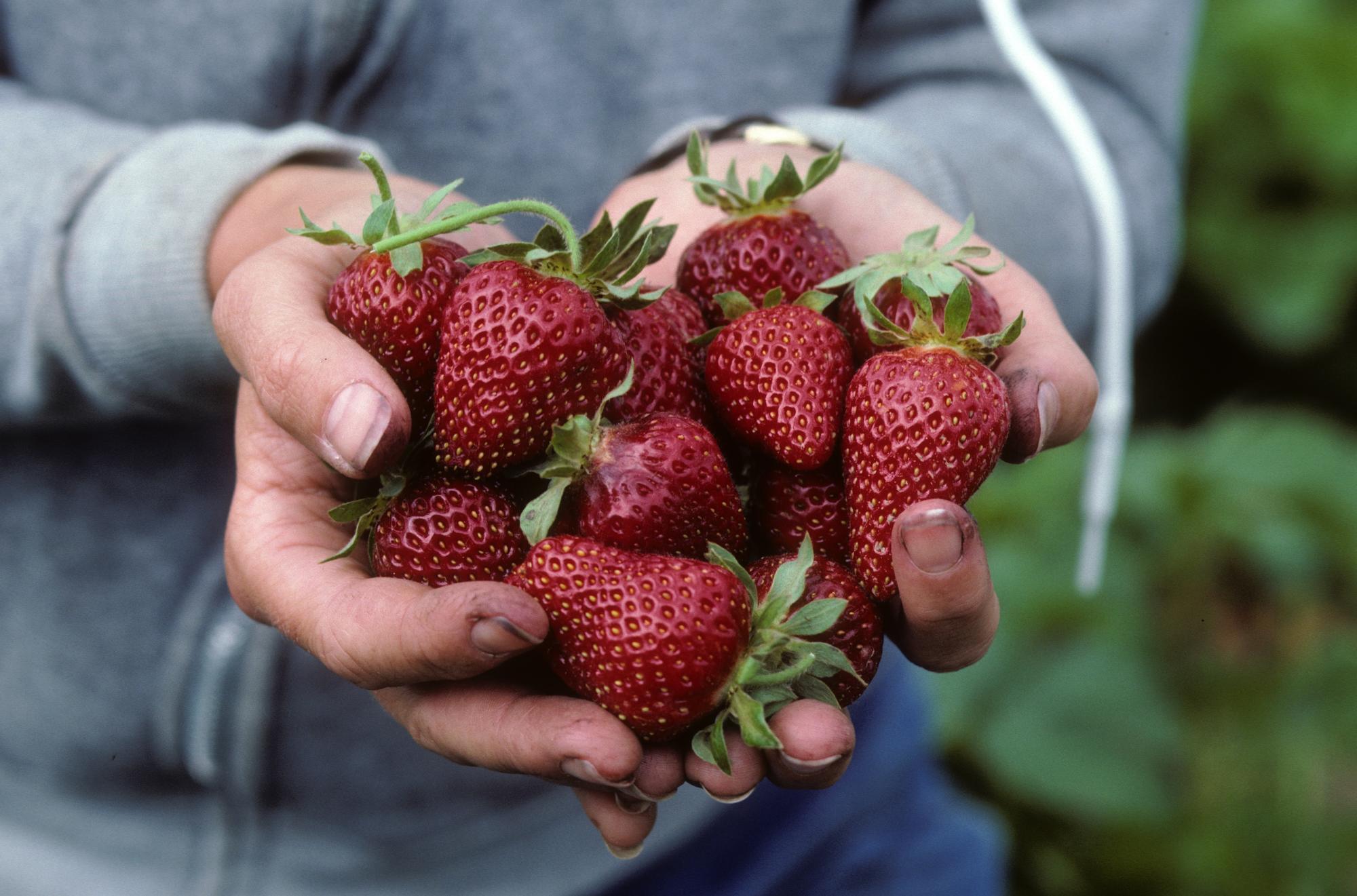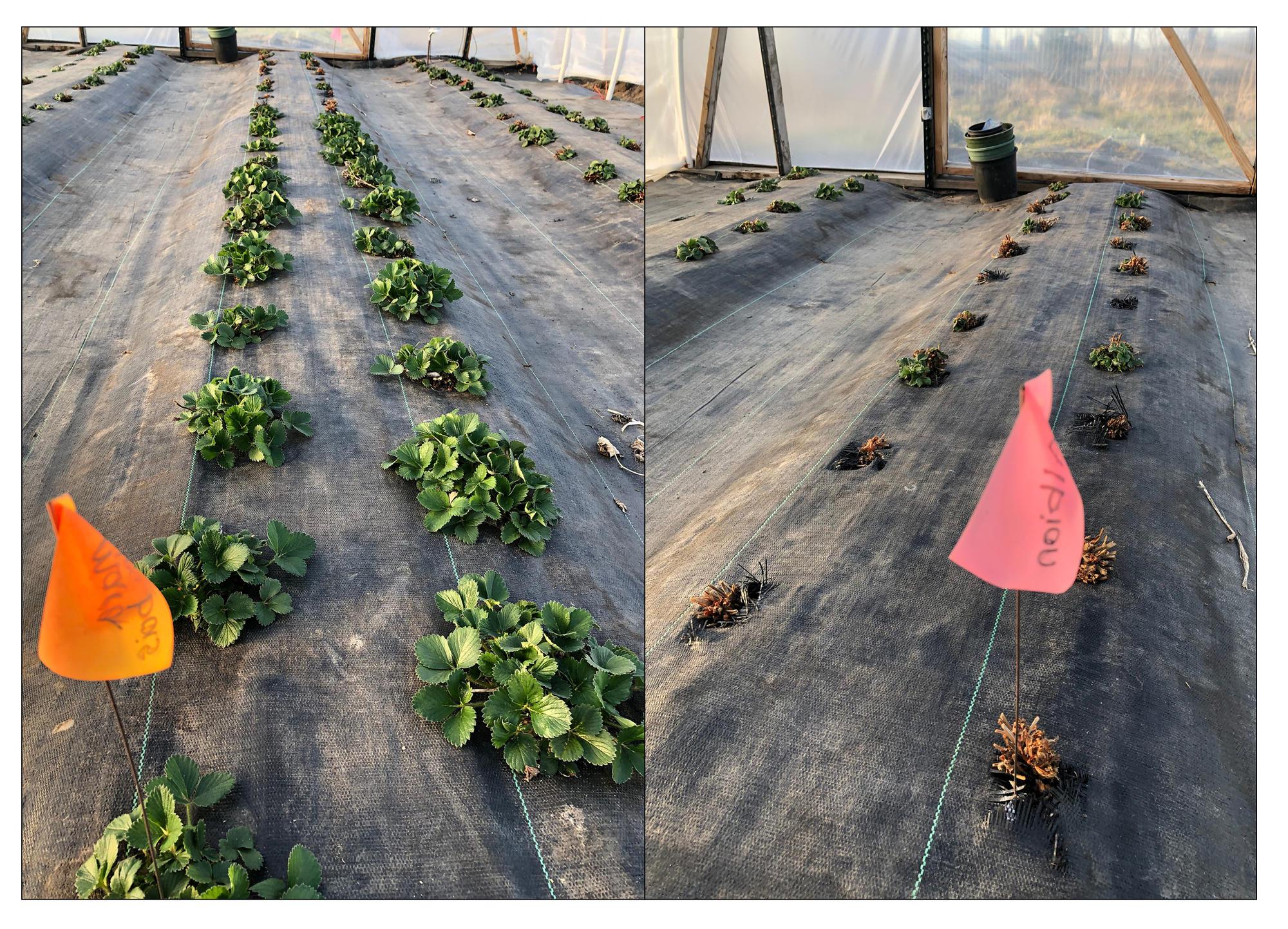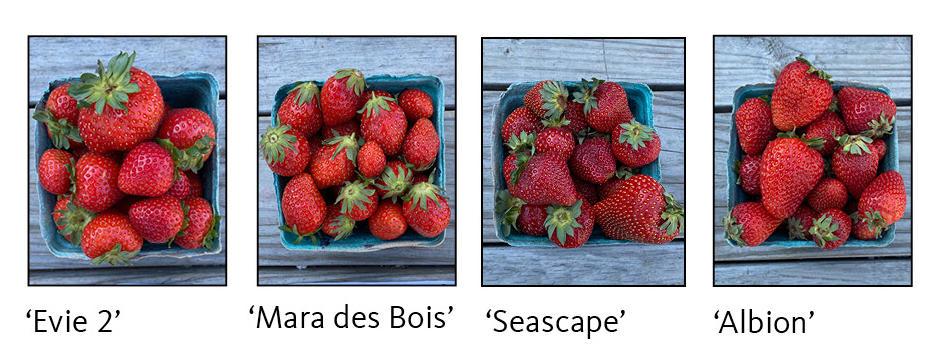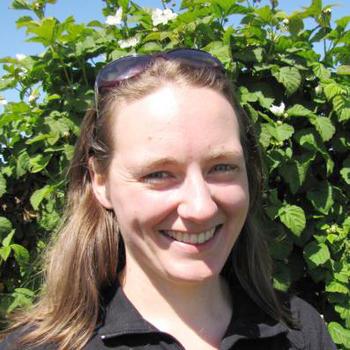Introduction
Strawberries are a high-value crop for farmers markets throughout North America. However, the high desert region of Central Oregon can be a particularly challenging place to grow strawberries and other horticultural crops. The high elevation (2,000–4,200 feet), arid environment and extreme daily temperature swings result in short growing seasons of about 90 days. Hard freezes are common in May and October, and frosts can occur in summer. Late-winter warm spells cause flower buds to emerge early and face late-spring frost damage, resulting in delayed harvest. Early fall frosts can end the growing season while fruit is still on the plants (Figure 1). Despite the challenges, strong demand for locally grown crops prompted some Central Oregon growers to explore using adapted cultivars and season-extension approaches to make strawberries a viable crop. Commercial producers in the region use cold-hardy species and cultivars and frost protection (high tunnels, low tunnels and row covers) to successfully grow vegetable crops and meet the demand.
This publication explores how to grow strawberries commercially in Central Oregon. It highlights the results of a two-year research project on field and high tunnel production of four day-neutral strawberry cultivars. This Central Oregon-based research applies to growing regions with similar environmental conditions throughout the western U.S.
OSU Extension publications that explain general strawberry production (including June-bearing types) include:
Growing Strawberries in Your Home Garden (EC 1307)
Growing Berries on the Oregon Coast: Strawberries (EM 9178)
Strawberry Cultivars for Western Oregon and Washington (EC 1618)
Utah State University resources on high desert strawberry production can be found at: www.berry.usu.edu. Washington State University’s publication, Growing Day-Neutral Strawberries in Western Washington, includes specific considerations for organic production. You can find additional useful resources at www.fruit.cornell.edu.
1. General strawberry management
Site selection and preparation
Strawberries are adaptable to different growing conditions, but proper site selection minimizes management challenges. Plants tolerate some shade, but growers need full sun to achieve high yields and top quality. Late spring frosts in Central Oregon often kill the early strawberry blooms that produce the largest berries (Figure 1). Raised beds reduce bending (Figure 2) but cause the soil to warm up earlier in the spring. This causes earlier flowering and higher frost-damage risk, making frost protection critical. Flat beds with late winter shade — such as on the north side of a building or windbreak — reduce the need for frost protection. Covering plants with straw mulch in late winter will also delay soil warming and early flower bud emergence.
Plant in well-drained soil with moderate organic matter content. Strawberry roots grow in the top 12 inches of soil, so your soil should be at least 8-12 inches deep. This will optimize water- and nutrient-holding capacity for plant growth. Take an advance soil test, ideally one year before planting, to determine fertilizer and soil amendment needs. The pH for many soils east of the Oregon Cascades is neutral to alkaline. The optimum soil pH for strawberries is 5.5–6.5. Watch for iron and zinc deficiencies in strawberries when soil pH is greater than 7. Day-neutral strawberries require approximately 60–80 pounds of nitrogen per acre in the first year. Soil fertility and organic matter content will dictate how much N you need. Apply organic preplant fertilizer well before planting so it will mineralize and be available for plant uptake. Table 1 provides the recommended soil nutrient ranges for strawberries. See OSU’s Strawberry Nutrient Management Guide for Oregon and Washington for specific recommendations.
Plantings are typically in the ground for at least two growing seasons, so start with a disease- and weed-free area. Many strawberry cultivars are susceptible to Verticillium wilt, a soilborne disease that can persist for years and also attacks tomatoes, potatoes, eggplants, small fruits and other plants. Avoid planting strawberries where these plants have been grown within the last five years. Look for cultivars with Verticillium resistance.
Spreading perennials such as quackgrass and bindweed are the most troublesome weeds in strawberry beds. For hill-type management, where runners are removed (as opposed to matted row where runners are allowed to root), plant through a weed barrier, such as landscape fabric or plastic mulch (see Planting and spring care). A cover crop planted the previous year will help with soil fertility and weed control.
Selecting cultivars
Strawberry cultivars are classified as June-bearing, everbearing and day-neutral.
- June-bearing types initiate flower buds under short days in the fall. Flowers emerge the following spring and ripen in June, although it could be later in cold climates.
- Everbearing strawberries produce fruit in early and late summer with a significant gap in between. Everbearing strawberries are not commercially viable. Day-neutral strawberries are sometimes called everbearing, causing confusion.
- Day-neutral strawberries initiate flowers regardless of day length, as long as temperatures are between 40° F and 85° F. They can produce from June to October in colder, higher-elevation regions such as Central Oregon. When midsummer temperatures routinely exceed 85° F, day-neutral fruit production can temporarily drop off.
This publication focuses on day-neutral strawberries because they produce in the first year of planting, have season-long production, and are more forgiving when spring frosts eliminate early flowers and fruit. Information on June-bearing types is available in (Growing Strawberries in Your Home Garden (EC 1307) and Strawberry Cultivars for the Intermountain West from Utah State University.
Regardless of type, fresh-market strawberries should be cold-hardy, flavorful, large and disease-resistant. Growers should start with certified disease-free nursery stock from a reputable nursery to avoid introducing pathogens to their location. Nurseries often run out of stock of their best cultivars and only ship plants at certain times of the year. Plan and order in advance. Many cultivars are patented and cannot be propagated without a license.
Planting and spring care
Remove runners from day-neutral strawberries in the hill system so you can manage plants as individuals throughout the planting life. Plant on flat ground or raised beds, leaving 1.5- to 2-foot aisles. You can control weeds by covering beds with plastic mulch or landscape fabric. Plant dormant bare-root plants through the plastic mulch in a staggered double (or triple) row down each bed, with 12–15 inches between rows on the bed and 12–15 inches between plants in the row (Figure 3).
Planting depth is key; the margin between planting too deep (and causing crowns to rot) and too shallow (allowing roots to dry out) is thin. Set bare-root plants deep enough so roots are covered with soil and not bent and that the crown midpoint is level with the soil surface (Figure 4). Plant as soon as the ground is workable and irrigation water is available. Dormant plants tolerate cold temperatures. As plants grow, remove the first flower clusters until at least two branch crowns form. This encourages strong plant establishment. Remove runners throughout the season. This focuses growth on crown and fruit development (Figure 5).
Temperature management
Strawberries begin growing above 40° F. Emerging flower buds can’t withstand cold temperatures and will be damaged at 22° F. Unopened white petals suffer damage at 26° F. Open flowers die at 30° F. Growers must first use temperature management to protect emerging flower buds from frost, and then provide optimal growing conditions for longer periods.
Frost protection
Under some growing conditions, you can protect emerging flowers on cold nights by covering them in freezing water with overhead sprinklers. As long as there is some liquid water on the surface, the flower temperatures will not drop below 32° F. This option doesn’t work in windy or low-humidity conditions common in Northwest high-elevation deserts; surface water will evaporate faster than it freezes, accelerating freeze damage. High tunnels (passively heated greenhouse-type structures), low tunnels and floating row cover (or crop blankets) can protect plants from frost in Central Oregon. These approaches provide about 3°–4° F of protection. You may need to combine approaches to protect buds and blossoms. For example, you can install low tunnels inside high tunnels.
High tunnel management
In addition to frost protection, high tunnels allow you to start earlier in the spring, accelerate spring development and continue growing later in the fall. Optimal plant growth occurs at 70°–75° F. Plants grow slower and do not flower above 85° F. Timely closing of high tunnels, ventilation and shade cloth will maintain optimal temperatures. Monitoring temperature is key in Central Oregon, where midsummer outdoor temperatures are in the 90s and 100s. Even in cooler months, closed high tunnel temperatures can exceed 100° F. See Temperature Management in High Tunnels for more information.
Pollinators and high tunnels
Strawberries need pollinators to develop fruit, so when flowers emerge and temperatures support pollinator activity, open high tunnels and lift row covers to allow pollinator access. Bumblebees and flies pollinate when it’s sunny and over 45° F. Honey bees prefer temperatures above 55° F. Plan to move and replace covers as needed. When it’s not feasible to open or close a high tunnel, stock it with commercially available bumblebee colonies.
Yearly care
Irrigation and plant nutrition
Drip irrigation is ideal. You can also use the drip system to apply fertilizer, a process called fertigation. If you use overhead irrigation, water in the morning so the foliage dries and is less susceptible to foliar disease. High-desert strawberries typically have fewer diseases.
Established strawberries need 1–2 inches of water per week during the growing season. This may require irrigation three or more times per week. After the establishment year, day-neutral strawberries need 60–100 pounds of nitrogen per acre (1.4 to 2.3 lbs N/1,000ft2) for optimal production. The nitrogen should be supplied throughout the growing season. Strawberries planted into plastic mulch should receive in-season fertility through fertigation. For more information, see Strawberry Irrigation and Strawberry Nutrient Management Guide for Oregon and Washington.
Harvest and storage
Keeping berries cool will extend their shelf life. Harvesting the fruit when the air temperature is cool, keeping it out of direct sunlight and quickly moving the fruit to coolers maintains postharvest quality. Harvest before rain or frost. Schedule your harvest according to when you sell the fruit. Strawberry shelf life is several days under ideal conditions, but most growers sell them within 24 to 48 hours of picking.
Berry picking is hard work, and picking speed will vary by cropping system and picker motivation and skill. A fast picking speed of five to seven flats per hour is possible during the main season when the fruit is large and easy to spot and detach. Picking is slower (two to four flats per hour) early or late in the season when berries are small or buried within the foliage.
The labor requirements prompt many growers to adopt the ‘U-pick’ alternative. U-pick reduces harvest and handling costs, introduces customers to your farm, and is a good option for cultivars with smaller fruit or shorter shelf life. However, this option can disrupt farm operations and damage your crops.
Winter care
Do not remove dying plant leaves in the fall until they are dead; dying leaves contribute to carbohydrate storage (Figure 6). Remove dead leaves without damaging crowns. Snow cover protects crowns from mid-winter cold snaps, and clean straw mulch protects plants in snowless areas with sub-zero temperatures. In the spring, that straw mulch will cool the soil, delay flowering and reduce frost damage. If you do not want to delay flowering, remove your straw mulch earlier.
2. Research in Central Oregon
Introduction
A research project evaluated the viability of day-neutral strawberry production for Central Oregon to determine if high tunnels increased profitability and fruit quality. Participants evaluated four day-neutral strawberry cultivars — 'Albion', 'Evie 2', 'Mara des Bois', and 'Seascape' (Table 2) — in high tunnel and field plantings at five Deschutes County locations. An OSU researcher managed the main trial, and local farmers conducted four additional trials with some variations of the main trial treatments. Participants established plants in spring 2019 and evaluated them for two growing seasons (2019–2020). The WSARE Final Report contains full details.
| Cultivar | Berry size | Flavor | Firmness | USDA Zone | Disease resistance |
|---|---|---|---|---|---|
| ‘Albion’ | Large-Very large | Excellent | Very firm | 4–7 | Verticillium |
| ‘Evie 2’ | Large | Moderate | Moderate | 4–8 | Leaf diseases |
| ‘Mara des Bois’ | Small | Good | Moderate | 4–7 | n/a |
| ‘Seascape’ | Large | Good | Firm | 4–7 | n/a |
Main research site
The main research site was on a small commercial farm near Alfalfa, Oregon, at an elevation of 3,400 feet above sea level. The trial replicated plots of each cultivar in a high tunnel and an open field (Figure 7). Individual field plots were 20 feet long, and high tunnel plots were 10 feet long. The high tunnel was a low-cost PVC-framed structure measuring 14 feet by 45 feet. The soil was a sandy loam with 2% organic matter and a soil pH of 6.6.
We applied preplant organic fertilizer and soil amendments according to soil test results. We then formed raised beds (8 inches tall and 24 inches wide, 4 feet apart on center). We installed two lines of irrigation drip tape per bed. The beds and alleys were covered with landscape fabric to control weeds. Covering alleys is not common practice, but we did it due to limited labor at the main research site. We planted bare-root dormant plants through the fabric at 1-foot spacing in double rows (Figure 7).
The May 5, 2019, planting was later than optimal for day-neutral cultivars but was dictated by the nursery’s shipping schedule. We removed emerging flower clusters until early June to allow for strong crown development, though this timing depends on the planting date.
We irrigated every three days from mid-April to early October 2019 and 2020. We fertilized in-season with liquid fish fertilizer. In 2019, we used a backpack sprayer to supply a total of 15 pounds of N per acre at the base of plants, and in 2020 we fertigated bi-weekly to supply a total of 70 pounds N per acre. We removed emerging runners to enhance root and crown development. HOBO weather stations recorded soil and air temperatures in the field and high tunnel throughout the study. We installed shade cloth on the high tunnel when temperatures were consistently above 85 F.
Ripe berries were harvested twice a week. The 2019 season consisted of 22 picks from July 16 to Oct. 1. The 2020 season consisted of 37 picks between May 25 and Oct. 20 (see Production season below). At each pick, berries were separated into "marketable" and "unmarketable" fruit, counted and weighed to determine yield and average fruit size. Fruit was rated as unmarketable (or "cull") if there was insect or disease damage or if the fruits were misshapen or small. The total marketable yield was the accumulated yield over the growing season and reported as pounds per plant.
Results
Temperature management
The extreme swings in ambient temperature in Central Oregon (Table 3) make high tunnel management challenging. Tunnels kept minimum daily temperatures 3° F warmer than the open field (Table 3).
| Month | Average temp. (°F) |
Min temp. (°F) |
Max temp. (°F) |
|||
|---|---|---|---|---|---|---|
| Field | Tunnel | Field | Tunnel | Field | Tunnel | |
| 2019 | ||||||
| June | 59 | 65 | 27 | 30 | 91 | 112 |
| July | 64 | 68 | 32 | 35 | 95 | 103 |
| Aug | 66 | 67 | 34 | 37 | 98 | 99 |
| Sep | 54 | 58 | 27 | 31 | 89 | 100 |
| Oct | 40 | 47 | 3 | 7 | 77 | 94 |
| 2020 | ||||||
| March | 35 | 42 | 6 | 10 | 71 | 98 |
| April | 45 | 48 | 12 | 14 | 79 | 89 |
| May | 55 | 57 | 19 | 23 | 93 | 99 |
| June | 59 | 61 | 26 | 29 | 96 | 99 |
| July | 66 | 67 | 30 | 36 | 100 | 101 |
| Aug | 65 | 66 | 31 | 34 | 100 | 101 |
| Sep | 58 | 59 | 26 | 29 | 100 | 100 |
| Oct | 46 | 48 | 3 | 9 | 90 | 89 |
Shade cloth installed in July 2019 and June 2020 reduced daytime high temperatures. The high tunnel provided critical protection for emerging buds and flowers in May and June but did not extend the season in the fall. Freezing temperatures destroyed the remaining fruit in the field and high tunnel (see Production season below). Temperature management was not optimal in this study. Temperature management requires careful attention to the conditions and period adjustments for tunnel ventilation, which was difficult to do in a research setting. Earlier installation of shade would have also been helpful.
Yields
'Evie 2' was the highest-yielding cultivar across both seasons. 'Albion' was the lowest. (Figure 8). Tunnel-grown plants had higher total marketable yields than field-grown plants across all cultivars and for both seasons (Figure 8).
Yields in the field ranged from 0.6 pounds to 1.0 pounds per plant in the first year and from 0.8 pounds to 1.9 pounds per plant in the second year. Yields in the tunnel ranged from 0.8 pounds to 1.4 pounds per plant in the first year and from 1.4 pounds to 2.7 pounds per plant in the second year.
Considering the late planting date that delayed establishment, yields approaching 1 pound per plant in the first year are quite good. Yields exceeding 2 pounds of marketable fruit per plant (in the tunnels) in the second season are excellent. Field production averaging 1.5 pounds per plant across all cultivars is also very good, considering the lack of frost/freeze protection. These results suggest that day-neutral production could work well for Central Oregon growers. For reference, 2 pounds per plant equals approximately 1,000 pounds (or 125 flats) of fruit from a 14-foot by 90-foot tunnel at our planting density.
Production season
The fruit production season in the first year (2019) was similar between the tunnel and the field. This is not surprising. Strawberries were not planted until May, harvest started in late July and ended with a hard freeze at the end of September.
The harvest season in the second year (2020) was four to six weeks longer in the tunnel than in the field (Figure 9), with 'Mara de Bois' being the earliest to produce and 'Albion' the latest.
Weekly yields fluctuated in the summer, likely due to extremely high temperatures that would have inhibited flowering and the tendency of day-neutral strawberries to produce in flushes. The 2020 high tunnel production season peaked in mid-July for 'Evie 2', 'Mara des Bois' and 'Seascape', and later for 'Albion'. High tunnel production dipped in the hottest part of the summer and rose from mid-September to October when freezing temperatures hit (Figure 9). Field production peaked in mid-July as tunnel production waned, providing complementary production that suggests a farmer could maintain strawberry production all season by employing both methods.
Because the early and late-season harvests tended to be quite small (Figure 9), an "effective harvest season" was calculated to illustrate the main harvest season differences between cultivars and growing systems.
The effective harvest season started once 20% of the total yield was reached and ended once 80% of the total yield was reached. In 2019, the effective harvest season was mid-August to mid-September. In 2020, the effective harvest season varied by cultivar but started two to three weeks earlier in the tunnel than in the field (Figure 10).
Fruit quality
Fruit size and unmarketable fruit are reported only for the effective harvest season (Table 4). Fruit size varied early in the season, and late-season harvests had high cull rates due to frost injury and rain damage. High tunnel fruit tended to be larger for 'Albion' and 'Evie 2'. Larger berries are more desirable for a grower since fewer berries are needed to fill a pint. 'Mara des Bois' was smaller than other cultivars and cull rates were highest (Table 4). 'Mara des Bois' yields in 2020 were exceptional, but the small fruit size, misshapen fruit and higher cull rate make it less desirable for the pre-picked market.
Cull rates were similar between cultivars and growing systems in 2019 (Table 4). The main cause of culls was bronzing and misshapen fruit. There was more variability in cull between cultivars and growing systems in 2020. Culls were mainly caused by herbivory and misshapen fruit, and cull rates tended to be higher in the high tunnel where rodent and bird damage was worse.
Winter survival and spring growth
Plant survival between September 2019 and April 2020 was higher for tunnel-grown plants (93%) than for field-grown plants (91%). 'Mara des Bois' had the highest plant survival (100% field, 97% tunnel) and the most vigorous spring growth. 'Albion' had the lowest winter survival rate (82% field, 79% tunnel) and emerged later than other cultivars (Figure 11). Due to its later emergence and maturity, 'Albion' may be a good choice to avoid spring frost damage if you do not have frost protection.
| Cultivar | Average fruit size (g/berry) | Unmarketable (%) | ||
|---|---|---|---|---|
| Field | Tunnel | Field | Tunnel | |
| Year 1—2019 | ||||
| 'Albion' | 14.4 | 15.6 | 6.4 | 6 |
| 'Evie 2' | 12.9 | 14 | 6 | 4.9 |
| 'Mara des Bois' | 6.5 | 7.8 | 7.2 | 6.8 |
| 'Seascape' | 11.6 | 11.9 | 5.7 | 4.2 |
| Year 2—2020 | ||||
| 'Albion' | 12.4 | 13.9 | 6.7 | 12.6 |
| 'Evie 2' | 11.3 | 14.3 | 9.9 | 16.9 |
| 'Mara des Bois' | 7.3 | 8.8 | 13.2 | 13.7 |
| 'Seascape' | 11.2 | 12.8 | 11.7 | 12.9 |
3. Grower-cooperator experience
All four cooperator sites were organically managed diversified vegetable farms. All farms trialed at least two cultivars in field and tunnel production, although tunnel types differed among locations (Table 5). Climate and soil conditions varied among sites: elevation ranged from 2,750 to 3,500 feet above sea level; soil pH ranged from 6.2 to 7.1; and soil organic matter varied from 3% to 10%. Management (preplant fertilizer, weed fabric, planting dates) was similar across all farms and harvested yields were tracked over two years.
Evie 2 was the highest-yielding at cooperating sites, but growers reported its softer berries were easily bruised and harder to bring to market. Most found the flavor of Evie 2 to be bland. Albion was the lowest-yielding and the latest maturing, but growers preferred its large, firm fruit and excellent flavor. The upright plant architecture and less dense foliage made picking easier and more efficient, unlike Evie 2 and Mara des Bois.
Cooperators said labor and time for harvest were the biggest challenges. Two farms had to stop harvesting at the end of August 2020, even though the plants still produced berries. Diversified Central Oregon farms are busy from late August to early September, and growers prioritized their vegetable crops, which are their main market. Still, three farmers planned to expand strawberry acreage the next year and were happy they participated in the study.
| Trial site | Tunnel width and height | Cultivars trialed | 2019 harvest season | 2020 harvest season | 2019 Highest total yield | 2020 Highest total yield |
|---|---|---|---|---|---|---|
| Farm 1 | Quonset style 20' W x 9' H | 'Evie 2', 'Seascape' | HT 6/15–9/8 F 7/15–9/9 |
HT 5/8–8/288 F 7/8–9/1 |
'Evie 2' in HT: 0.9 lb/plant | 'Evie 2' in HT: 1.3 lb/plant |
| Farm 2 | Quonset style 20' W x 9' H | 'Evie 2', 'Mara', 'Seascape' | HT & F 7/31–10/8 |
HT & F 7/31–10/8 |
'Evie 2' in HT: 1.1 lb/plant | 'Evie 2' in HT: 1.1 lb/plant |
| Farm 3 | Caterpillar 12' W x 8' H | 'Albion', 'Mara', 'Seascape' | HT 7/26–10/1 F 7/26–9/12 |
HT 5/25–10/25 F 6/252–10/6 |
'Mara' in HT: 0.7 lb/plant | 'Seascape' in HT: 1.8 lb/plant |
| Farm 4 | Caterpillar 14' W x 7' H | 'Albion', 'Evie 2', 'Seascape' | HT 7/10–10/4 F 7/16–9/27 |
HT 6/6–10/9 F 7/13–10/9 |
'Evie 2' in HT: 1 lb/plant | 'Evie 2' in F: 1.6 lb/plant |
1 Plants were still producing, but the grower stopped harvesting fruit.
2 Albion harvest started nearly three weeks later (7/16).
3 Albion harvest started two weeks later (7/14).
Growers reported enthusiastic consumer responses. (“They taste like a real strawberry!” said one buyer.) The fruit sold easily at a good price even though it was later in the season than consumers expect. Berries from other regions arrived at farmers markets earlier in the summer.
Growers said they would use more season extension (high tunnels or low tunnels or both) and focus on cultivars that produce premium berries, such as Albion. “I would not do any outdoor production,” one producer said. “I would only plant with drip irrigation and have a way to fertigate. I would have better airflow within the greenhouse. I would only plant Albion. The timing seemed good, and the row cover helped early production.”
| Cultivar | Positives | Negatives |
|---|---|---|
| 'Evie 2' | Highest yield Large fruit size, round berriesMost uniform fruit shapeGood performance in tunnel and fieldEarly maturity, long picking seasonGood winter survival, better in tunnel |
Softer fruit, short shelf life "Bland" flavorLowest grower preference |
| 'Mara des Bois' | Unique flavor, very aromatic High yieldEarly maturity, long picking seasonVery good winter survival |
Small fruit size Lighter red color, softer fruitHigh cull rate due to misshapen fruitSmall fruit size and heavy vegetation made picking difficult |
| 'Seascape' | Firm fruit Good flavorMedium to large fruit sizeConsistent harvest across seasonEasy to pick, berries detached easilyVery good winter survival |
Somewhat variable fruit shape |
| 'Albion' | Excellent flavor Very firm berries, easy to transportLarge fruit size, uniform fruitPreferred variety of grower participants |
Later maturity, shorter picking season Lowest yieldLower winter survivalRunner production whole season |
Pest management challenges
In addition to the need for careful temperature management and adequate harvest labor, growers noted that thrips and spider mites were more of a problem in high tunnels at several sites. The pests caused bronzing and deformed fruit. Study participants used predator insect releases, Beauveria bassiana (Mycotrol) and azadirachtin (neem oil) to manage these issues. The high tunnel at one site also had earwig damage. Common leaf spot caused late-season leaf damage in high tunnels at two sites and was likely caused by overhead irrigation or poor ventilation or a combination of the two. Rodent damage was severe in the high tunnel at multiple sites and led to both overwinter plant death and in-season fruit culls. Bird damage was also severe at multiple sites and led to in-season fruit culls. Bird netting draped over the beds was used at one site to reduce pressure, but made picking more time-consuming.
For comprehensive pest management information, refer to the Pacific Northwest Pest Management Handbooks and Defending the Castle: Integrated Pest Management in High Tunnel Strawberries.
Economic considerations
Growers in Central Oregon consider strawberries to be a two-year investment. Averaged across all cultivars, the total marketable two-year yields in this study were 3.2 pounds per plant in the high tunnel and 2.3 pounds per plant in the field. Individual cultivars also gained roughly 1 pound per plant from the field to the high tunnel. How much of an economic impact this pound-per-plant factor makes depends on how large of an area of berries you grow.
Based on these yields (3.2 and 2.3 pounds per plant) and the planting density used in our study (1-foot spacing in double rows, beds 4 feet on center), a couple of scenarios help illustrate the potential impact:
- A 14-foot-by-90-foot high tunnel with three beds of strawberries would produce roughly 1,610 pounds (205 flats) of berries over two years. The same area in the field would produce approximately 1,160 pounds (140 flats). These flat numbers are based on our average pint weights of 0.65 pounds per pint in the high tunnel, 0.69 pounds per pint in the field and 12 pints per flat. At $4 per pint, that equates to roughly $9,840 in the tunnel and $6,720 in the field.
- A 50-foot bed (100 plants) would equate to roughly a 100-pound difference between growing systems over two years: 320 pounds (41 flats) in the high tunnel and 230 pounds (28 flats) in the field. At $4 per pint, that equates to roughly $1,970 in the tunnel and $1,344 in the field.
These numbers are based on total marketable yield, which included several smaller picks at the beginning and end of the season. If a grower did not want to take the time to harvest and sell the smaller picks, the total yields would be lower, but absolute differences between growing systems would be similar. Also, these numbers only reflect estimated gross income differences. Growers need to consider their costs, anticipated yields and prices. The costs of land preparation, nursery stock, plant nutrition, and bringing your berries to market will be the same for high tunnel and field production. For tunnel production, consider the extra cost of the high tunnel, added labor for an extended harvest, added labor for tunnel management (such as monitoring temperatures, opening and closing), and potentially higher pest management costs.
Conclusions
Yields of day-neutral strawberries, particularly in the second season, were impressive, indicating that this is a commercially viable crop for the high-elevation arid climate of Central Oregon. It appears that temperatures remain cool enough that day-neutral production can continue all summer, with outdoor production performing better in the hot summer months but high tunnels allowing a much longer season and higher yields. High tunnels alone may not give enough protection from fluctuating spring temperatures, and low tunnels or row cover within high tunnels may be needed for spring production. This may also help early production to be more consistent since the first several weeks of harvest in our trial were quite low and may not be worth bringing to market. If earlier production is the main goal, growers may want to consider planting strawberries in the fall and using a high tunnel to accelerate spring harvest. See High Tunnel Strawberry Production for Early Spring Harvest for more information and results from Utah. One challenge to these fall-planted systems is the availability of nursery plants. Also, the system has not been tested in Central Oregon.
When selecting cultivars for a local direct market, overall yields may be a secondary priority to high-quality berries with good flavor and post-harvest shelf life. The two highest-yielding cultivars tested in this study were rated as inferior by the cooperating growers due to small fruit size, poor post-harvest shelf life and bland flavor. However, consumer response was positive for all cultivars tested, and farmers market customers were eager to buy local fruit. Ultimately, the suitability of this system for a diversified operation will depend on target markets, seasonal labor availability and high tunnel space. Our results indicate that day-neutral strawberry production presents a promising opportunity for Central Oregon growers.




